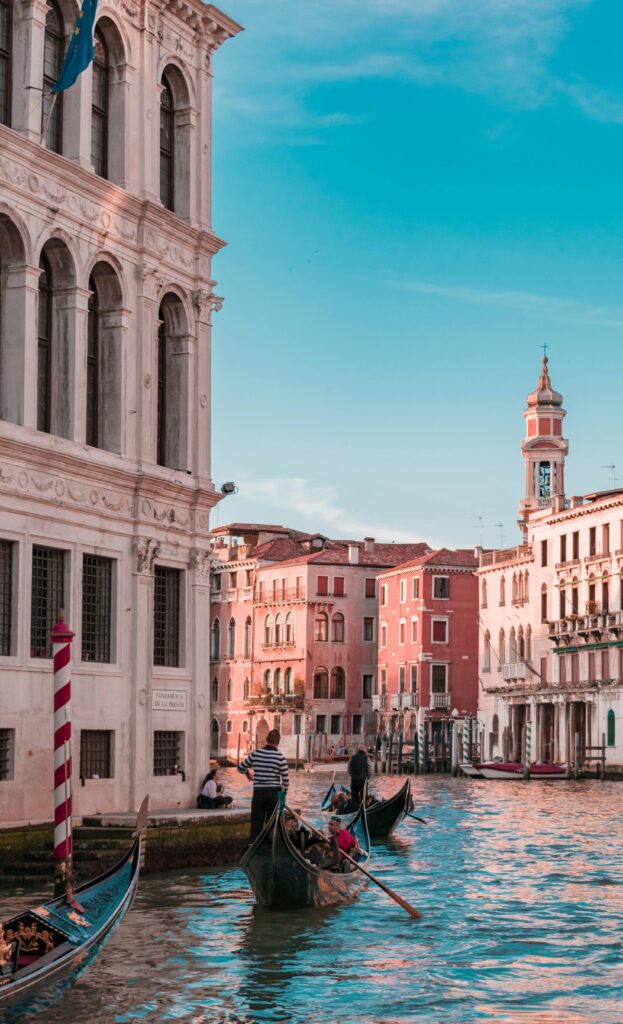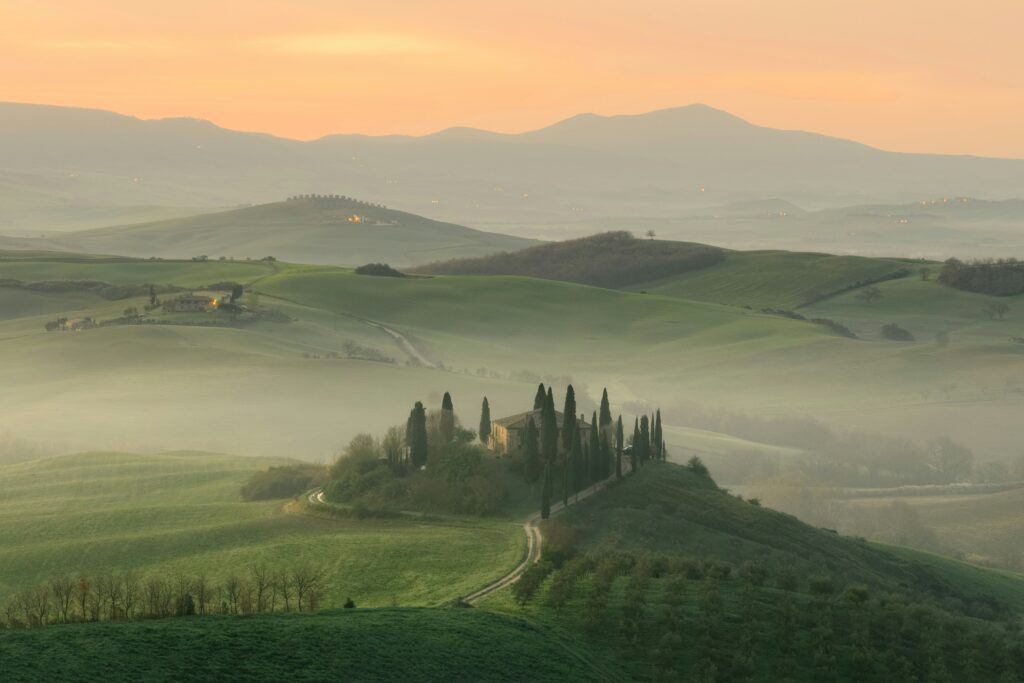Italy, a country steeped in history and culture, offers a diverse range of tourist attractions. Here are some of the most popular cities and regions:
North Italy

- Rome: The Eternal City, home to iconic landmarks like the Colosseum, the Pantheon, and the Vatican City.
- Florence: A Renaissance city renowned for its art and architecture, including the Uffizi Gallery, the Duomo, and the Ponte Vecchio.
- Venice: A unique city built on canals, with famous attractions like St. Mark’s Square, the Rialto Bridge, and the Doge’s Palace.
- Milan: A fashion capital known for its shopping, the Duomo, and the La Scala opera house.
- Cinque Terre: A coastal region with five colorful fishing villages and stunning hiking trails.
Central Italy

- Tuscany: A region famous for its rolling hills, vineyards, and medieval towns like Siena, Pisa, and San Gimignano.
- Umbria: A peaceful region known for its hilltop towns, olive groves, and vineyards.
- Apulia: A region with beautiful beaches, ancient towns, and delicious cuisine.
South Italy

- Naples: A vibrant city with delicious pizza, historical sites like Pompeii and Herculaneum, and the stunning island of Capri.
- Amalfi Coast: A scenic coastline with charming towns, stunning beaches, and dramatic cliffs.
- Sicily: The largest island in the Mediterranean, with ancient Greek ruins, Baroque architecture, and delicious food.
- Sardinia: An island known for its beautiful beaches, crystal-clear waters, and archaeological sites.
These are just a few of the many tourist attractions that Italy has to offer. With its rich history, culture, and stunning landscapes, Italy is a popular destination for travelers from all over the world.
Italy is a dream destination for many travelers, offering a rich history, world-class art, mouthwatering cuisine, and diverse landscapes. Whether you’re exploring the canals of Venice, the ruins of ancient Rome, or the Tuscan countryside, a trip to Italy requires thoughtful planning. Here’s an expanded guide to help you prepare for your Italian adventure:
1. Travel Documents
- Visa: Italy is part of the Schengen Zone, so if you’re from the EU or a Schengen Area country, you can travel freely without a visa. Travelers from the U.S., Canada, Australia, and many other countries can stay in Italy for up to 90 days without a visa for tourism purposes. Be sure to check your country’s visa requirements before you travel.
- Passport: Ensure that your passport is valid for at least six months beyond your planned departure date.
- Travel Insurance: It’s highly recommended to have travel insurance that covers health emergencies, trip cancellations, and theft or lost items. Healthcare in Italy is excellent, but private care can be expensive without insurance.
2. Entry Requirements
- COVID-19: While Italy has relaxed many COVID-19 entry requirements, you should still verify the latest regulations before your trip. In some cases, you may need proof of vaccination, a negative PCR test, or recovery from COVID-19.
- Customs Regulations: Be mindful of the items you can and cannot bring into Italy. The country has strict rules for bringing in tobacco, alcohol, and certain food products. If you are bringing in valuable electronics or other high-ticket items, make sure to declare them upon arrival.
3. Health Conditions
- Vaccinations: No specific vaccinations are required to enter Italy, but it’s wise to ensure your routine vaccinations (like tetanus, hepatitis A/B) are up to date.
- Pharmacies: Pharmacies, known as farmacie, are easy to find in Italy and are well stocked with over-the-counter medications. Pharmacies often have a green cross outside, and many have rotating night services.
- Healthcare: Italy has a highly regarded healthcare system, with many doctors and pharmacists speaking some English in major cities. Be aware that smaller towns might have fewer English-speaking healthcare providers, so it’s a good idea to have basic health-related phrases in Italian handy.
4. Currency and Payment Methods
- Local Currency: Italy uses the Euro (EUR). ATMs (called bancomat) are widely available, and credit cards are commonly accepted in cities. However, in rural areas, small family-run businesses, and local markets, it’s good to have some cash on hand.
- Credit and Debit Cards: Visa and Mastercard are accepted almost everywhere, while American Express may not be as widely accepted. Inform your bank of your travel plans to avoid any issues with blocked transactions.
- Tipping: Tipping in Italy is appreciated but not obligatory. A service charge (called coperto) is often included in restaurant bills. If service is not included, a tip of around 10% is customary for good service. You may also round up the bill in cafes and for taxi rides.
5. Language and Culture
- Language: Italian is the official language, and while many people in tourist areas speak some English, especially in cities like Rome, Florence, and Venice, learning a few basic Italian phrases can enhance your experience. Polite phrases like “Grazie” (Thank you), “Per favore” (Please), and “Buongiorno” (Good morning) are appreciated.
- Cultural Etiquette: Italians value manners and politeness. Greet people with “Buongiorno” (Good morning) or “Buonasera” (Good evening). When dining, avoid asking for modifications to dishes, as Italian cuisine is highly respected, and chefs expect their dishes to be enjoyed as they are presented. Dressing modestly is expected when visiting churches, particularly the Vatican, where shoulders and knees should be covered.
6. Safety
- Pickpocketing: Pickpocketing can be an issue in tourist-heavy areas like Rome, Florence, and Naples. Keep your belongings secure, especially in crowded spaces like public transport or busy squares. Use a money belt or anti-theft bag to protect your valuables.
- Scams: Be aware of common scams targeting tourists, such as people offering you “free” bracelets or roses, only to demand money afterward. Stick to reputable tour guides and avoid street vendors offering deals that seem too good to be true.
- Emergency Numbers: The general emergency number in Italy is 112 for police, fire, and medical emergencies.
7. Weather and Clothing
- Seasons:
- Summer (June to August): Summers in Italy can be very hot, especially in cities like Rome and Florence, with temperatures often exceeding 30°C (86°F). Light, breathable clothing, sun protection, and plenty of water are essential during this season.
- Winter (December to February): Winters can be chilly, particularly in the northern regions and mountainous areas. Cities like Milan, Turin, and Venice often see temperatures around 0–5°C (32–41°F). Pack warm clothes, especially if you’re visiting during the Christmas season.
- Spring and Autumn: Ideal times to visit for milder temperatures, with fewer crowds and comfortable weather for exploring. Pack layers as temperatures can vary throughout the day.
- Clothing: Italians tend to dress more formally than in some other countries, especially when dining out or visiting cultural sites. Avoid wearing beachwear away from coastal areas and dress modestly when visiting churches. Comfortable shoes are a must, as you’ll likely be walking on cobblestone streets or exploring ruins.
8. Transportation
- Trains: Italy has an excellent train system, and trains are one of the most efficient ways to travel between cities. Trenitalia and Italo are the two main rail companies, offering fast and affordable travel between major destinations. You can book tickets online in advance for discounts or at the station.
- Public Transport: In cities like Rome, Milan, and Naples, metros, buses, and trams are common. Tickets for buses and metros must be bought in advance at kiosks or tabaccherie (tobacco shops) and validated once you board.
- Taxis: Taxis are widely available in cities but are often more expensive than public transportation. Always use official taxis and avoid unlicensed cabs. Taxis do not usually stop on the street—use a taxi stand or call ahead.
- Car Rental: Renting a car is a great option if you plan to explore the countryside, particularly regions like Tuscany or the Amalfi Coast. Be aware that driving in cities can be challenging due to traffic and restricted zones (called ZTLs, or Limited Traffic Zones). International drivers may need an International Driving Permit (IDP) along with their local license.
9. Accommodation
- Hotels: Italy offers a wide range of accommodations, from luxury 5-star hotels to more budget-friendly options. Major cities like Rome, Florence, and Milan have global hotel chains as well as boutique options. In smaller towns, charming family-run inns or guesthouses may be a better option.
- Agriturismos: For a more authentic experience, consider staying in an agriturismo (farm stay), especially in rural areas like Tuscany or Umbria. These are working farms that offer accommodations, often with delicious homemade meals and a peaceful setting.
- Vacation Rentals: Short-term rental platforms like Airbnb or Vrbo are widely available, especially in major cities and tourist regions.
10. Emergency Numbers
- Police: 112
- Ambulance: 118
- Fire Services: 115
- Tourist Assistance: Major cities like Rome and Florence have tourist police who can assist with lost property or legal issues.
11. Internet and Telephony
- SIM Cards: If you need a local SIM card, you can easily purchase one at the airport or at telecom shops in the city. Providers like TIM, Vodafone, and WindTre offer prepaid plans with good data options. You’ll need your passport to buy a SIM card.
- Wi-Fi: Free Wi-Fi is common in hotels, cafes, and restaurants, especially in urban areas. Public Wi-Fi is available in many city centers but may be slow or unreliable in rural areas.
- Electricity: Italy uses 230V power, with Type C, F, and L plugs. Be sure to bring a universal adapter if your devices use different plug types.
12. Working Hours and Public Holidays
- Business Hours: Shops typically open around 9:00 a.m. and close at 7:30 p.m., with a break for lunch between 1:00 p.m. and 4:00 p.m., especially in smaller towns. Restaurants usually serve lunch between 12:30 p.m. and 2:30 p.m., and dinner from 7:30 p.m. to 10:30 p.m.
- Public Holidays: Italy observes several national and religious holidays, including Christmas (December 25), Easter, Ferragosto (August 15), and Republic Day (June 2). Many businesses and attractions may be closed or have reduced hours during these holidays.
13. Tipping
- Tipping is not mandatory in Italy, but it’s common to leave small tips for good service. In restaurants, if a coperto (cover charge) is included in the bill, an additional tip isn’t expected. If the service was excellent, you can round up the bill or leave 5-10% of the total. For taxi drivers, rounding up the fare is appreciated.
14. Cultural and Social Connections
- Italy is renowned for its rich cultural heritage, with world-class art galleries, ancient ruins, and historic cities. Whether it’s a visit to the Vatican Museums in Rome, the Uffizi Gallery in Florence, or exploring the Amalfi Coast, immersing yourself in Italian culture is easy.
- Italians are generally friendly and open to tourists. Enjoying a leisurely meal with locals or participating in traditional festivals like Carnival in Venice or the Palio horse race in Siena are great ways to experience Italian life firsthand.
15. Healthcare and Emergencies
- Hospitals: Italy has excellent healthcare, with both public and private hospitals providing high-quality care. Emergency services in public hospitals are generally free for tourists, but for non-urgent care, you may need to pay out of pocket or use travel insurance.
- Pharmacies: Italian pharmacies are highly regulated, and pharmacists can often provide medical advice for minor ailments. Look for a green cross sign to locate one. In emergencies, you can find pharmacies that operate 24 hours a day in major cities.
Final Tip:
Italy is a treasure trove of history, art, and culinary delights. Take your time to savor the local flavors, explore its iconic cities, and wander through charming villages. Remember that “la dolce vita” (the sweet life) is all about slowing down and enjoying every moment!

